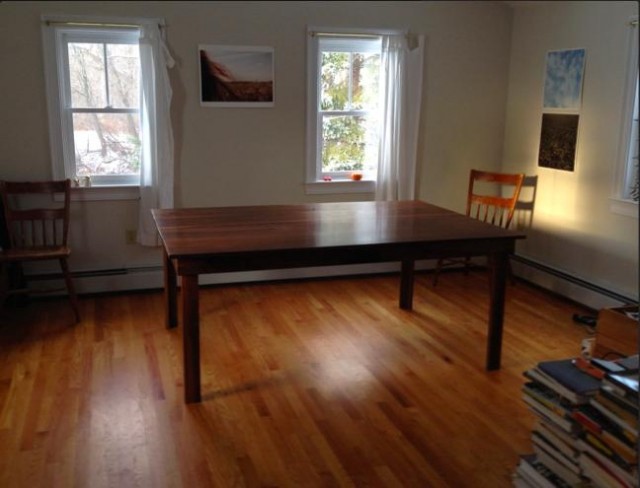On Setting a Price For Your Work
by Nina MacLaughlin

Time and materials. It’s a simple enough equation for how builders charge their clients. You are paid for the hours that you labor, and for the stuff needed for the job: the 2x4s and drywall and mesh tape; the tiles, the 80-pound sack of cement, the carton of grout; the lags, j-bolts, and pressure-treated 4x4s; the flooring, the paint, the baseboard, basecap, and crown molding.
For the past five years, I’ve been working as the assistant to a carpenter. My boss is a contractor who’s been in the trades for the last decade-plus. She and I build bookshelves, tile floors, tear down walls and put in new ones. We renovate kitchens from the floor to the ceiling. We redo bathrooms and attics and basements. We install skylights and build sturdy, beautiful decks. I am not involved in the estimates or the charging, and the pricing out of a job seems like a tricky thing, factoring in not just time and materials, but the unknowns we’ll inevitably encounter (a rotted joist below the floor; a windowframe pulped by woodchewing bugs), as well as how far away the job is and whether it’s on the third floor or first. I don’t know the math, the tangibles and intangibles that go into an estimate. What I do know is that my boss does extraordinary, high quality work and doesn’t charge enough.
Over and over, I’ve tried to convince her to charge more. I’ve been urging her to raise her hourly rate and charge the amount of money her work demands. It kills me when she says, after we’ve finished some big job, that after she’s paid me, as well as the plumbers, electricians, or plasterers she’s hired, that she only takes home a little for herself.
She raised her rates a few months ago, and I was thrilled to hear it. After all, how hard could it be to charge $3,000 for a set of built-in bookshelves as opposed to $1,800?
Much harder than I thought.
This last year was the first time I’ve had to charge people for the carpentry work I’ve done. As a gift for my brother, I made a table out of heartwood pine, a long table for feasts. It was a good first-go, crudely done and imperfect, but it does its job and the broad planks of wood had rich swirls. From there, other people, people I didn’t know, wanted me to make tables for them. I found myself for the first time in the position of having to put a value on the work.
So, time and materials. Wood is expensive. For a table I made out of lovely black walnut, six feet by four feet, the wood itself was close to $700. Another table, a round one, five feet across, I made with thick chestnut reclaimed from a salvaged barn in Monson, Mass. Those boards cost about $500. Time in these cases is not so straightforward: do I charge for the hours spent lying awake in bed planning out the project? Do I charge for the time spent putting the table together in my mind before I touch the wood? It would be unfair, at those early stages of table-building, to charge for every hour logged. So I come up with a number, almost arbitrary, based mostly on how much I’ve spent on wood. Oh, it has been uncomfortable saying, you owe me $950, which is what I charged for the big walnut table, or $800 for the round table made of chestnut. It sounds like so much money. But it is less than what they’re worth.
I’ve justified undercharging by telling myself I’m still learning, that these early commissions were opportunity to improve (and I have and continue to; each table is better than the last). It’s similar to the way writing used to feel: It used to be that being published was reward enough for the work. I was grateful for the opportunity to write, to have practice, to improve, and who cares if I was only paid $50, or nothing at all? I value my time more now. I value the writing work I do, and am able to be pickier about where to write for and how much they’ll pay. It took a while to get to that point.
The fact is, the tables are worth more than what I’ve been comfortable charging. It’s a matter of confidence, of recognizing that these tables I’ve made are lovely and strong and one-of-a-kind. As this year closes, as more table requests trickle in, as I get better and faster, I’m resolved to value the work, to value the labor, to value what I’m producing, and to follow the advice I’d given my boss for years.
Nina MacLaughlin is a writer and carpenter living in Cambridge, Massachusetts. Her book about leaving journalism for carpentry will be published by W.W. Norton.
Support The Billfold
The Billfold continues to exist thanks to support from our readers. Help us continue to do our work by making a monthly pledge on Patreon or a one-time-only contribution through PayPal.
Comments